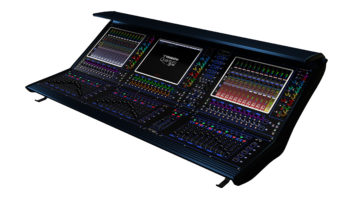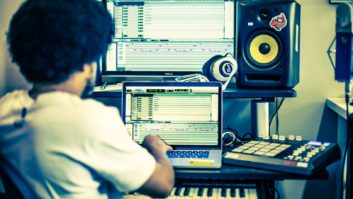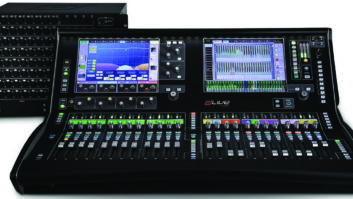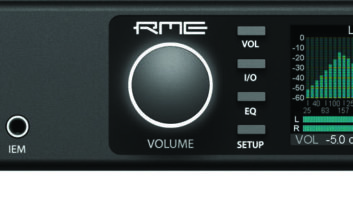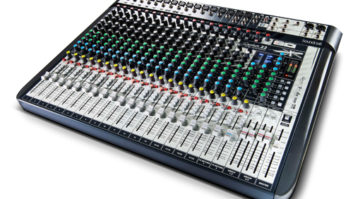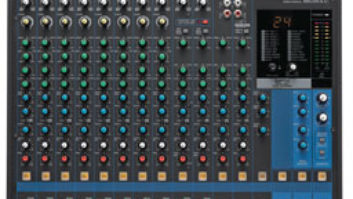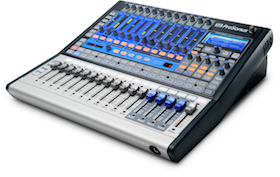
As music production moves increasingly into smaller recording studios, manufacturers are responding by creating consoles combining modest footprints with grandiose capabilities. And while the pace of new product introductions has slowed recently, the technologies being offered break fresh and exciting ground.
From the guy in a garage band who’s cutting his teeth on engineering, to the seasoned producer mixing an established act’s single, owners of small studios present a wide range of up- and down-market requirements and budgets. Manufacturers are addressing both niches with compact digital mixers that cost as little as $1,300, and small-frame analog consoles boasting sterling vintage circuitry that run in the tens of thousands of dollars.
Contemporary Trends
FireWire and USB-formatted I/O are becoming ubiquitous. Inexpensive digital mixers are being bundled with entry-level DAWs to present turnkey solutions to new engineers. For example, the PreSonus StudioLive 16.0.2 comes with the company’s proprietary Studio One Artist DAW, and the Yamaha 01V96i comes bundled with Steinberg’s Cubase AI.
Computer-based editor-librarian software—programs that remotely manage scenes and effects presets for mixer channels—have been around for years, and it’s now practically expected that a new digital console will include such a program for free. What’s new is that some consoles are now using iOS apps (run by Apple devices such as iPads and iPhones) to control ancillary computer cum mixer software from afar, allowing applications such as “more me” personal monitoring.
Built-in effects processing for low-cost digital mixers is becoming more sophisticated, too. Effects that model vintage analog processors are no longer the sole domain of DAW plug-ins but are being incorporated into Yamaha digital consoles. Digital effects algorithms from popular outboard processors are also being ported into these consoles.
Digital mixers differentiate themselves in other ways. Less-expensive consoles might keep costs down by offering non-motorized faders and hard-coded I/O routing (where input 1 has fixed routing to channel 1, input 2 always goes to channel 2, and so on). Consoles that provide freely assignable routing, on the other hand, allow you to route any input to any channel; for example, you can route a 2-track return to an input channel equipped with EQ or quickly conform a client’s DAW routings to your console’s mixing template. Motorized faders provide continuous WYSIWYG feedback of current levels while mixing, which is especially critical when new scenes are recalled.
New analog consoles are also meeting the needs of smaller studios. Automated Processes, Inc. (API) is loading its reissued vintage signal processors into small-frame consoles and adding new features—including 5.1 mixing and monitoring, and boutiquey à la carte signal chains—that oblige modern production techniques. Companies such as Toft Audio and Wunder Audio are installing knockoffs of classic Trident, Neve and API channel strips and buses in small console frames, lowering the entry price for high-end vintage sound. Meeting at the crossroads of analog and digital technologies are Solid State Logic’s AWS Series consoles, which offer pristine analog audio paths and DAW-control hardware under the same roof.
Let’s take a closer look at the innovative small-frame studio consoles introduced recently and their practical applications. We’ll specifically explore those consoles having 25 fader strips or fewer, multiple buses to accommodate multitrack recording, facilities for cue monitoring and a desktop (versus rackmount) configuration. I’ve excluded from this investigation dedicated control surfaces and boards that have a matrix section (found on consoles primarily intended for live sound reinforcement).
The PreSonus StudioLive 16.0.2 digital console has a footprint measuring less than two square feet and provides innovative remote-control capabilities.
Remote-Control
An innovative suite of proprietary software programs bestows a host of remote-control capabilities on the PreSonus StudioLive 16.0.2, a Lilliputian mixer that provides hard-coded 16×16 I/O via a built-in FireWire 400 port. (The console provides 32 additional mic/line inputs, but only 16 inputs in total can be accessed at once.) Open the included Virtual StudioLive (VSL) software, and you see a complete visual representation of the 16-channel console on your FireWire-equipped Mac or PC. Inside VSL, you control key functions of the mixer using a mouse, trackpad or trackball. For example, you can load your custom gate, compressor and EQ settings—individually or as a channel strip—into any channel of the 16.0.2 simply by dragging and dropping a preset onto the desired mixer channel in VSL’s GUI. Console-wide snapshots (mixer scenes) can also be loaded in a drag-and-drop jiffy. You can download (from the mixer) an unlimited number of scenes to your computer, name them, and then send them on a disk or via email or IM to a buddy who also owns a StudioLive mixer.
VSL can be used together with two apps (both available for free from the Apple App Store) to control your 16.0.2 from afar. The StudioLive Remote app turns your iPad into a remote controller for the mixer, while the QMix app (released at this year’s Winter NAMM) gives similar capabilities to an iPhone and iPod touch. Using StudioLive Remote, you can use your iPad to see and control signal-processing (gate, compressor and EQ) parameters, aux levels and so on in VSL, which then passes the control signals on to your 16.0.2 via FireWire.
Also, if each band member owns an iPhone or iPod touch, download the QMix app to each device, and they will automatically and wirelessly sync to the aux channels of the 16.0.2 console, creating up to four independent “more me” mono cue mixes (or two stereo cue mixes if the auxes are linked).

Analog-modeled effects, freely assignable I/O and motorized faders are some of the key features offered by the Yamaha 01V96i digital mixer.
Analog Emulator
The 24-bit Yamaha 01V96i digital console is giving leading DAW plug-ins a run for their money with its Virtual Circuitry Modeling technology. VCM effects emulate classic analog compressors, equalizers and stompbox phasers from the ’70s and the tape and circuitry characteristics of Swiss and American tape recorders from the ’70s and ’80s. Fans of the Yamaha SPX2000 Multi Effects Processor will also appreciate that the REV-X reverb algorithms have been ported over to the 01V96i.
The 01V96i provides up to 40 simultaneous inputs—including 16 bidirectional channels via USB 2.0, eight channels via ADAT Lightpipe and 16 mic/line inputs—and 20 buses at up to 96 kHz sampling rate. The 40 inputs are assigned to banks (fader layers) that are alternately allocated to the console’s 16 motorized channel faders. Like other contemporary Yamaha digital consoles, the 01V96i features freely assignable I/O. Eight user-defined keys can be configured as mute-group masters, copy-and-paste prompts for channel settings or virtually any other console function, providing shortcuts for your most frequently performed tasks.
All the console’s parameters can be controlled using the included Editor software. With Editor, you can store your mixer scenes and patch lists offline and load them into any 01V96i console. The patch lists comprise your console routings for inputs, outputs, inserts and direct outs, as well as assignments of effects presets to multiple channels.

Solid State Logic’s AWS 924 console pairs high-end analog audio with sophisticated DAW-control hardware.
Hybrid Solution
Solid State Logic’s AWS (Analogue Workstation System) consoles combine pristine, high-headroom SuperAnalogue circuitry with DAW-control hardware. The latest model in the series, the AWS 924, features 24 inputs (with as many faders), two classic EQ curves for every channel (the EQ is 4-band), two assignable SSL Dynamics, the legendary Stereo Buss Compressor, Total Recall and 5.1 monitoring with bass management. A 48-input variant, the AWS 948, is also available.
The 924 interfaces with your DAW via MIDI over Ethernet and provides dedicated transport controls (buttons to initiate play, record, rewind, fast-forward and stop), LED-fitted V-Pot rotary encoders, digital scribble strips and a TFT display. The 924’s faders use the Mackie Control protocol to tweak your DAW plug-ins from the console, while the TFT display shows plug-in parameters. The V-Pots can execute routing assignments or show DAW channel and send levels on its LEDs. The classic Ultimation-based automation facilities have been recently updated to include a new A-FADA mode, in which the motorized analog faders follow DAW automation data.
The 924’s jog/shuttle wheel can be used to scrub your DAW tracks. You can zoom and select DAW objects directly from the console. Other controls mirror most of the functions that would otherwise be executed by a QWERTY keyboard, making the 924 a virtually self-contained DAW-control environment.

The API 1608 incorporates the classic 212L mic pre and 550A and 560 EQs.
Analog Bastion
API’s 1608 console updates the vintage API 1604 mixer with new, modern features. Each of the 8-bus console’s 16 input channels incorporates a classic API 212L mic preamp. Twelve input channels are fitted with the ’60s-era API 550A three-band equalizer, the other four channels with the vintage API 560 10-channel graphic equalizer (from 1969). Both equalizers utilize the legendary 2520 op amp and proportional-Q circuitry, which progressively narrows the filters’ Q at extreme boost and cut settings.
The 1608’s rear jack panel has more routing capabilities than air traffic control. In addition to the expected mic and line inputs and insert send and return jacks, every input channel provides a post-fader direct output, ¼-inch high-impedance instrument input and ¼-inch jacks for the equalizer input and preamp output. One application is you can patch an outboard mic preamp directly to a console channel’s API 550A or 560 equalizer and then send the equalized signal to other outboard gear via the insert send jack (which is immediately post-EQ).
The 1608 is fitted with eight empty echo-return slots which you can fill with any API 500 Series modules. Each slot has a balanced input and output jack, allowing you to build a custom signal chain of high-end API mic pre, compressor and EQ for recording directly to your multitrack recorder or DAW.

The Toft Audio ATB08M features the classic 80B equalizer that was the hallmark of the legendary Trident 80 Series console.
Classic-Analog Revivalists
Fans of the vintage Trident Series 80 console who can’t afford the hefty price or accommodate the large footprint, you’re in luck: The Toft Audio ATB08M is an 8-channel mixer that features the identical 80B 4-band equalizer (plus 80Hz highpass filter) that largely defined the sound of that classic console. Additional features include eight mix buses with outputs, direct outs on every input channel, in-line monitoring (switching the monitor return to the channel fader), eight subgroups (with inserts), six aux sends, eight stereo aux returns and a meter bridge. The aux returns can be used as 16 more inputs during mixdown.
4-, 16-, 24- and 32-channel configurations of the ATB Series console are also available. The 4-channel version, the ATB04M, differs from the others in that it has only two subgroups and two auxes. The meter bridge, switchable to show levels for either the channel inputs or monitor returns, is optional for 16-channel and larger configurations. All outputs are electronically balanced.

The Wunder Audio Wunderbar analog console provides three vintage-flavored stereo buses, the outputs for which can be used discretely or mixed together. A 12-channel configuration is shown here.
The Wunder Audio Wunderbar console gives you three vintage flavors to choose from at once: Wunder, Neve and API. Inputs can be routed to one of three stereo buses, each imparting one of these flavors. The Wunder bus is identical to that used in the custom-made, 1971-era Allotrope console owned by John Paul Jones (of Led Zeppelin fame). The Neve and API buses are based very closely on the Neve 1272 and API 312 preamps, respectively; the only differences are some of the components are new. The three vintage buses can be used as mono or stereo subgroups and their signals blended together on the Wunder bus, or they can be used to simultaneously print three discrete stereo mixes (one for each flavor).
The Wunderbar’s 8-channel monitor section can be used for aux returns or extra inputs and can be bused to the three vintage-flavored stereo buses. Every input channel features a transformer-balanced direct out and insert and the Wunder PEQ1-style equalizers (incidentally, one of the best-sounding equalizers this author has ever heard). The modular console is available in frame sizes from 12 to 60 input channels (in 12-channel increments) and features in-line monitoring. Third-party ShadowMix automation is available as an option.
Advance Guard
Expect to see more iOS apps for and analog-modeled effects processing in the digital mixers of tomorrow. Deeper integration with DAWs is quickly unfolding. Witness, for example, Avid’s EUCON Phase II update, which adds more than 500 additional Pro Tools commands and complete Pro Tools menu access to the touchscreen controllers on Avid System 5 and Fusion consoles.
Despite ever-expanding capabilities on the digital side, however, there will always be a demand for knockoffs of vintage analog channel strips loaded into console frames. Pick your pleasure. No matter how you like to work, there’s a console designed to be a perfect fit.
Mix contributing editor Michael Cooper (myspace.com/michaelcooperrecording) is a mix and mastering engineer based in Oregon.
Console Manufacturers
There are many consoles on the market besides those featured in this article. Some have more channels and I/O suitable for very large productions. Others are primarily boards designed for live sound but which can do double duty multitracking in your studio. And don’t overlook older digital mixers; some have had potent software updates that greatly expand their capabilities.
